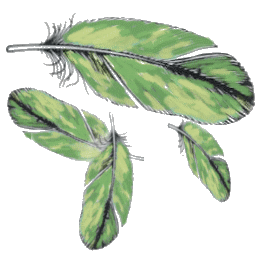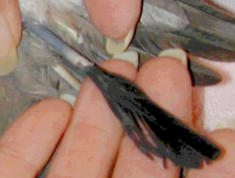QUICK PICK MENU
*Current avian vet practice is leaning toward not pulling wing feathers. Wing feathers must be removed at the right angle, in line with the direction of growth. Even if removed correctly, there is danger of the new feather becoming incysted as it tries to emerge from beneath the skin. Sometimes, the follicle can become damaged, and a new feather cannot grow as a result.
Pulling tail feathers is not as difficult, but current thought is not to pull a bleeding tail feather unless it doesn't stop bleeding.

When you see the words "blood feathers� for the first time, they can be a little scary. Blood feathers are simply developing feathers that still have a blood supply to the shaft. You can spot them by the dark, bluish/purple quill, shaped like a thick tube, as opposed to the white or clear shaft of a mature feather. Usually, they will be shorter than surrounding feathers and won�t look as mature. Blood feathers contain an artery and a vein with a circulating supply of blood running through the quill. As a feather grows, the blood recedes.
Blood feathers are located on different areas of a bird's body, depending on what molting stage the bird is in. Baby birds growing their first set of feathers have all their blood feathers at one time, and they will look like little pin cushions.

When you clip your bird's wings, or have a professional avian groomer or avian vet clip your bird�s wings, make sure each quill is examined to identify each shaft as not being a blood feather before clipping is begun. This way, the chance of accidentally clipping a broken blood feather is minimized.
Blood feathers are usually tender and sore. Birds with blood feathers should be handled gently. If a blood feather is broken, bent or accidentally cut, it allows the blood to flow through the open shaft, and can it bleed profusely, causing the blood feathers to become dangerous. Pulling the broken blood feather is the only permanent way to stop bleeding caused by the broken blood feather, but, avian vets are curently leaning toward not pulling blood feathers. Please see * in the QUICK PICK MENU.
As a rule, QPS advises Quaker owners to consult or visit their avian vet in all cases of emergency, a yearly well bird check up, and for grooming. When a blood feather has been damaged, the amount of visible blood can be alarming to the owner. It may be necessary for an owner to remove a damaged and bleeding blood feather themselves.
If it is necessary for an owner to pull a blood feather, it is easier if you have another person to assist you; one person to hold the bird in a towel and one to pull the blood feather out. Use needle nose pliers or a hemostat. Tweezers will not work.
Gently extend the wing and support it so no damage is done to delicate bones. Grasp the feather at the base, closest to the skin. One firm, smooth pull is all that is needed. Yanking willing hurt the bird and cause more damage than good. If pulled smoothly, the feather should come out of the follicle easily.
After the feather has been removed, apply a coagulant sparingly. Your thumb and index finger can be used to add pressure to the area for a few minutes to help stop follicle bleeding. The area will be sore. If you have Clotisol supplied from your vet, it can be applied. Cornstarch is recommended as well. Both will sting less than septic powders.
Quaker owners should examine their birds daily for things like blood feathers and any signs of feather change, or anything that might indicate a change in health. It is important to accustom your bird to being comfortable with a physical examination, not just for immediate examination, put to eliminate some of the stress that occurs in an emergency situation.
Blood feathers are completely normal. While not the primary cause of blood feather breakage, improper wing clipping can be a contributing cause of frequent blood feather damage. QPS does advise that you have your Quakers� wings trimmed professionally with a conservative clip so that blood feathers may be protected adequately, be aware of any blood feathers your bird might have, and ensure that the cage your bird is housed in is roomy enough not to contribute to blood feather breakage.